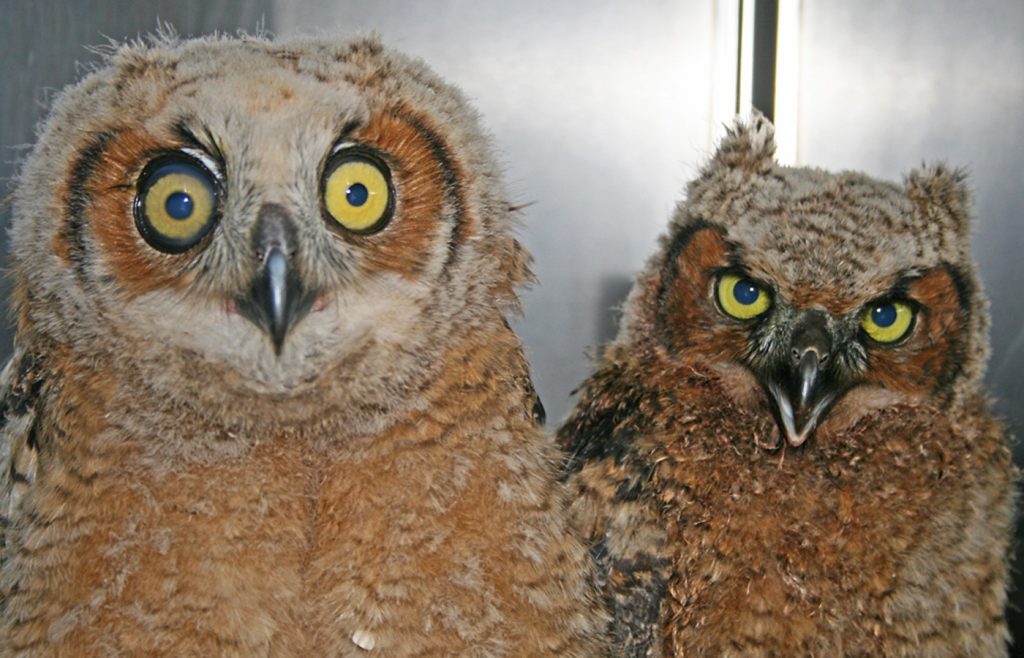
Every spring, flowers bloom, snow melts, and wild babies are born. Every spring in my wildlife rehabilitation office, the telephone begins to ring. Last spring, while I held a critically injured owlet on the exam table, sure enough that phone began to ring. When I was finally able to answer, the relief in the caller’s voice was palpable.
“Oh! Thank God! I thought it would be the voicemail again. Thank God! My name is Wesley Vanderhouse. I live at 1414 West Branch Road. I need someone over here right away! There is a young hawk in my yard . . . and . . . it’s . . . it’s just standing there!”
In retrospect, my ability to maintain calm and speak respectfully to the caller while holding a very injured owlet was as much a testament to my training as it was to my patience.
Contrary to popular belief, very young birds do not require human intervention in most cases. I began my response to the caller by politely questioning him about the size and color of the bird in order to identify the species and offer him more information for his peace of mind.
“Sounds like you’ve got a juvenile red-tailed hawk in your yard. Congratulations, sir! I can assure you he is as shocked to see you as you are to see him.” The man then began to relax and even laugh. I told him that red-tails were beginning to fledge and explore their world. Fledgling raptors are like toddlers, clumsily exploring at their own peril and learning important life lessons along the way.
Growth Stages
Baby birds, raptors and non-raptors alike, are called nestlings when they are living in the nest. During this period, which lasts from a few days to two weeks, the birds are growing at a tremendous rate. The parents are extremely busy collecting food to feed the nestlings. Both parents take turns guarding the nest and hunting for food.
In the next stage in growth, a baby raptor becomes a “brancher” when it starts exploring around the nest. At this stage the baby raptors are almost full size but the juvenile feathers have yet to appear. Instead of sleek flying machines, these branchers look oddly fluffy due to the white downy feathers that are keeping them warm.
After branching, young raptors become fledglings. When a bird begins to fledge, it leaves its nest and tree to explore new territory. This stage may begin days before the bird is capable of flight, so that when confronted by a human, the fledgling is unable to fly away and often freezes in terror. Left to its own devices, a fledgling raptor will later return to the tree from which it came not by flying but by climbing. Young raptors can climb before they can fly, using their strong curved beak and sharp talons.
The vulnerability of youth is not without peril. Despite the fact that parent birds are almost always nearby while these new explorers take on their first adventures, some young birds will succumb to predators, injury, or disease.
But They Look So Helpless!
The most common mistake humans make when encountering baby birds in the wild or in backyards is to intervene unnecessarily. We humans have an innate desire to care for the young, which is why we swoon over human infants as well as puppies and baby animals of all sorts. In the case of baby birds, a raptor frozen in terror as it faces a giant predator is often mistaken for an abandoned orphan. Consider the following scenario…
A well-meaning person walks through a park, sees a young flightless bird, and assumes it is in need of immediate assistance. Often a person picks up the bird, brings it home, then tries to feed and water it. Because a human kitchen is unlikely to supply freshly killed rats, mice, squirrels, moles, rabbits, and other birds, odds are a human will substitute inappropriate food, such as dog and cat kibble or canned food, hamburger, crackers, or cereal.
Birds Need Bird Parents
Additionally, taking a baby bird from the wild and feeding it is not only against the law, but it will also result in a permanent injury. Young birds of all types learn their identity from those that feed them. This means that if during a critically sensitive period of growth, such as between egg hatch and juvenile flight, a bird is cared for primarily by humans and not by its own kind, that bird will not identify itself as a bird at all. This injury is called human imprinting and it results in behaviors such as attempting to seek out humans as mates and an inability to identify dangerous predators. Imagine a great horned owl joining you at a romantic picnic at sundown because it mistakenly assumed you would provide it with a skunk to eat.
So if you find a baby bird this spring, take a step back. Ask yourself, is there an immediate threat to this bird? Is there blood and an obvious injury? If not, then walk away and leave it be. Do you see the nest the baby belongs in? Go ahead and put it back. It is a common myth that a parent bird will not care for its baby after it has been touched by human hands. If you don’t see the parent around, do not fret! It is likely they are hiding from you, you scary predator!
Still concerned? Call a local licensed wildlife rehabber in your area and ask for advice. In the Cedar Rapids/Iowa City area, call the Macbride Raptor Project at (319) 398-5495.
